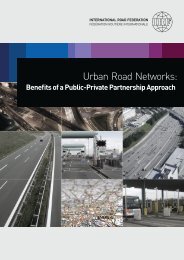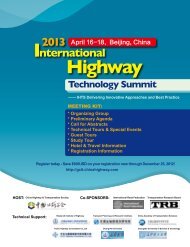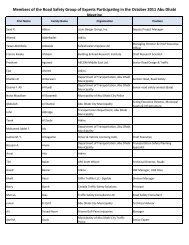TRANSPORT
TRANSPORT
TRANSPORT
- No tags were found...
Create successful ePaper yourself
Turn your PDF publications into a flip-book with our unique Google optimized e-Paper software.
SOCIO-ECONOMIC BENEFITS<br />
and creating employment. In times of recession, many<br />
countries take deliberate steps to increase investment<br />
on infrastructure works in the hope of maintaining low<br />
unemployment rates, stabilising markets and jump-starting<br />
their economies. Such a strategy has been successfully<br />
applied by highly developed countries, like the USA and<br />
Germany, as well as by developing countries like China,<br />
India and South Africa. Many countries in Sub-Saharan<br />
Africa utilise infrastructure investment to drive employment<br />
creation and combat poverty. These choices have their<br />
foundation in the following four principal facts:<br />
1. Infrastructure development works consume huge<br />
investment, which can be used to boost employment.<br />
Public infrastructure expenditure in most developing<br />
countries accounts for 40-60% of their annual<br />
budgets.<br />
2. They are relatively easy to organise and yield results<br />
that are both immediate and visible.<br />
3. Unemployment and poverty threaten the peace and<br />
stability of a country, and stifle long-term economic<br />
growth.<br />
4. Government is a last resort employer. When all<br />
market forces fail to function, it is the obligation of<br />
governments to intervene, through policy and by<br />
undertaking strategic programmes to stabilise the<br />
situation.<br />
Infrastructure investment is being increasingly used to<br />
address social imbalances and create opportunities for<br />
historically disadvantaged community groups (women,<br />
youths and persons with disabilities), and as an interim<br />
employment-based social protection mechanism. These<br />
are achieved through the use of Employment Intensive<br />
Technology (EIT), which involves reorientation of public<br />
sector expenditure towards infrastructure (roads, urban<br />
drainage works, irrigation schemes etc.) and the use of<br />
more local labour and resources.<br />
Experiences in several countries (including Kenya) have<br />
shown that employment intensive methods are generally<br />
cheaper and produce a well-engineered product. Provided<br />
they are well organised and managed, they also result in<br />
a speed and quality comparable to conventional machinebased<br />
methods. In addition, employment intensive<br />
methods promote the creation of productive employment<br />
for the rural and urban poor, as well as the development<br />
of local industries.<br />
Kenya pioneered the use of EIT, and has been implementing<br />
successful employment intensive road projects since the<br />
days of the Rural Access Roads Programme (RARP) in<br />
the 1970s and the Minor Roads Programme (MRP) in the<br />
80s. Both programmes provided much-needed access to<br />
rural communities, created employment and helped in<br />
stimulating the local economy in almost all parts of Kenya.<br />
These two programmes were followed by the Roads 2000<br />
Maintenance Concept, which was specifically aimed at<br />
dealing with the prevailing maintenance backlog covering<br />
the entire road network of Kenya.<br />
IRF BULLETIN SPECIAL EDITION: RURAL <strong>TRANSPORT</strong>, VOLUME-2 | 09
















